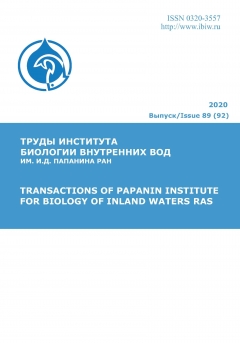Россия
УДК 574.64 Водная токсикология
Исследована взаимосвязь содержания ртути (Hg) в мышцах окуня Perca flutiatilis L., 1758 (Perciformes, Percidae) с длиной рыб из разных плесов Рыбинского водохранилища и нижнего бьефа ГЭС Угличского водохранилища, различающихся по своим физико-химическим характеристикам. Измерение Hg в образцах проводили атомно-абсорбционным методом на ртутном анализаторе РА-915+ с приставкой ПИРО (Люмэкс) без предварительной подготовки проб, пределы обнаружения Hg в биологических образцах — 0.0005–2.0000 мг/кг. Средние концентрации металла варьировали от 0.004 до 0.87 мг/кг сырой массы при средней длине рыб 2.2–45.0 см и различались по плесам. Влияние длины рыб на содержание металла в мышцах характеризовали коэффициентом наклона линии регрессии (показатель интенсивности накопления Hg) и уровнем пересечения линии с осью Y (показатель базового содержания Hg в организмах начала трофической цепи) по каждой указанной группе. Установлено, что интенсивность накопления Hg окунем длиной до 10 см достоверно снижается при дальнейшем увеличении размеров рыб и зависит от участка вылова в пределах Рыбинского водохранилища.
ртуть, Perca fluviatilis, Рыбинское водохранилище
1. Гремячих В.А., Ложкина Р.А., Комов В.Т. Пространственно-временная вариабельность содержания ртути в речном окуне Perca fluviatilis Linnaeus, 1758 (Perciformes, Percidae) Рыбинского водохранилища на рубеже XX–XXI веков // Трансформация экосистем. 2019. Т. 2, № 2(4). С. 85–95.
2. Гремячих В.А., Ложкина Р.А., Котиков Д.Э., Комов В.Т. Концентрации ртути в мышцах разных видов рыб из водоемов Ярославской области и прилегающих территорий // Труды Института биологии внутренних вод им. И.Д. Папанина РАН. 2022. Вып. 100(103). С. 35–56. DOI:https://doi.org/10.47021/0320-3557-2022-34-56.
3. Жаков Л.А. Формирование и структура рыбного населения озер северо-запада СССР. Москва: Наука, 1984. 144 с.
4. Житло Я.И. Исследования по питанию молоди окуня Валдайского озера // Известия ВНИОРХ. 1939. Т. XXII. С. 55–71.
5. Комов В.Т., Гремячих В.А., Камшилова Т.Б., Лобус Н.В. Содержание ртути в мышцах окуня из Полистово-Ловатского верхового болотного массива // Труды Государственного природного заповедника Рдейский. 2009. № 1. С. 102–115.
6. Леонова Г.А., Калмычков Г.В., Гелетий В.Ф., Андрулайтис Л.Д. Содержание и характер распределения ртути в абитических и биотических компонентах экосистемы Братского водохранилища // Биология внутренних вод. 2006. № 2. С. 97–104.
7. Рыбинское водохранилище и его жизнь. Л.: Наука. 1972. 364 с.
8. Структура и функционирование экосистемы Рыбинского водохранилища в начале XXI века / ред. В.И. Лазарева. М.: РАН, 2018. 456 с.
9. Backstrom C.H., Buckman K., Molden E., Chen C.Y. Mercury levels in freshwater fish: Estimating concentration with fish length to determine exposures through fish consumption // Arch. Environ. Contam. Toxicol. 2020. Vol. 78. P. 604–621. DOI:https://doi.org/10.1007/s00244-020-00717-y.
10. Burger J., Gochfeld M. Mercury and selenium levels in 19 species of saltwater fish from New Jersey as a function of species, size, and season // Sci. Total. Environ. Vol. 409. P. 1418–1429. DOI:https://doi.org/10.1016/j.scito tenv.2010.12.034.
11. Cebalho E.C., Díez S., dos Santos Filho M. et al. Effects of small hydropower plants on mercury concentrations in fish // Environ. Sci. Pollut. Res. 2017. Vol. 724. P. 22709–22716. DOI:https://doi.org/10.1007/s11356-017-9747-1.
12. Clayden M.G., Kidd K.A., Chételat J. et al. Environmental, geographic and trophic influences on methylmercury concentrations in macroinvertebrates from lakes and wetlands across Canada // Ecotoxicology. 2014. Vol. 23. P. 273–284. DOI:https://doi.org/10.1007/s1064 6-013-1171-9.
13. Depew D.C., Burgess N.M., Anderson M.R. et al. An overview of mercury concentrations in freshwater fish species: a national fish mercury dataset for Canada // Can. J. Fish. Aquat. Sci. 2013. Vol. 70. P. 436–451.
14. Eagles-Smith C.A., Willacker J.J., Flanagan Pritz C.M. Mercury in fishes from 21 national parks in the Western United States — inter- and intra-park variation in concentrations and ecological risk. U.S. Geological Survey Open-File Report 2014-1051. 2014. P. 54.
15. Eagles-Smith C.A., Wiener J.G., Eckley C.S. et al. Spatial and temporal patterns of mercury concentrations in freshwater fish across the Western United States and Canada // Sci. Total Environ. 2016. Vol. 568. P. 1171–1184. DOI:https://doi.org/10.1016/j.scitotenv.2016.03.229.
16. Eagles-Smith C., Silbergeld E.K., Basu N. et al. Modulators of mercury risk to wildlife and humans in the context of rapid global change // Ambio. 2018. Vol. 47. P. 170–197. DOI:https://doi.org/10.1007/s1328 0-017-1011-x.
17. Environmental chemistry and toxicology of mercury / Eds. Liu G., Cai Y., O'driscoll N.A. New Jersey: Wiley J. & Sons, INC. 2012. 600 p.
18. Gabriel M.C., Kolka R., Wickman T. et al. Evaluating the spatial variation of total mercury in young-of-year yellow perch (Perca flavescens), surface water and upland soil for watershed–lake systems within the southern Boreal Shield // Sci. Total Environ. 2009. Vol. 407. P. 4117–4126. DOI:https://doi.org/10.1016/j.scito tenv.2009.03.019.
19. Grandjean P., Cordier S., Kjellström T. et al. Health effects and risk assessments. Dynamics of mercury pollution at regional and global scales. Part IV. NY: Springer, 2005. P. 511–538.
20. Grigal D.F. Inputs and outputs of mercury from terrestrial watersheds: a review // Environ Rev. 2002. Vol. 10. P. 1–39. DOI:https://doi.org/10.1139/a01-013.
21. Haines T.A., Komov V., Jagoe C.H. Lake acidity and mercury content of fish in Darvin national reserve, Russia // Environ. Pollut. 1992. Vol. 78. № 1–3. P. 107–112.
22. Hinck J.E., Schmitt C.J., Chojnacki K.A., Tillitt D.E. Environmental contaminants in freshwater fish and their risk to piscivorous wildlife based on a national monitoring program // Environ. Monit. Assess. 2009. Vol. 152. P. 469–494. DOI:https://doi.org/10.1007/s1066 1-008-0331-5.
23. Ivanova E.S., Eltsova L.S., Komov V.T. et al. Assessment of the consumptive safety of mercury in fish from the surface waters of the Vologda region in northwestern Russia // Environ Geochem Health. 2022. Vol. 45(3). P. 863–879. DOI:https://doi.org/10.1007/s10653-022-01254-4.
24. Julian P., Gu B. Mercury accumulation in largemouth bass (Micropterus salmoides Lacépède) within marsh ecosystems of the Florida Everglades, USA // Ecotoxicology. 2014. Vol. 24. P. 202–214. DOI:https://doi.org/10.1007/s1064 6-014-1373-9.
25. Kamman N., Burgess N.M., Driscoll C.T. et al. Mercury in freshwater fish of Northeast North America: a geographic perspective based on fish tissue monitoring databases // Ecotoxicology. 2005. Vol. 14. P. 163–180. DOI:https://doi.org/10.1007/s10646-004-6267-9.
26. Karagas M.R., Choi A.L., Oken E. et al. Evidence on the human health effects of low level methyl mercury exposure // Environ Health Perspect. 2012. Vol. 120. P 799–806.
27. Karimi R., Chen C.Y. Pickhardt P.C. et al. Stoichiometric controls of mercury dilution by growth // Proc. Natl. Acad. Sci. 2007. Vol. 104 P. 7477–7482. DOI:https://doi.org/10.1073/pnas.06112 61104.
28. Kasper D., Forsberg B.R., Amaral J.H.F. et al. Reservoir stratification affects methylmercury levels in river water, plankton, and fish downstream from Balbina hydroelectric dam, Amazonas, Brazil // Environ. Sci. Technol. 2014. Vol. 48. P. 1032–1040. DOI:https://doi.org/10.1021/es4042644.
29. Kasper D., Palermo E.F.A., Branco C.W.C., Malm O. Evidence of elevated mercury levels in carnivorous and omnivorous fishes downstream from an Amazon reservoir // Hydrobiologia. 2012. Vol. 694. P. 87–98. DOI:https://doi.org/10.1007/s10750-012-1133-x.
30. Kidd K.A., Muir D.C.G., Evans M.S. et al. Biomagnification of mercury through lake trout (Salvelinus namaycush) food webs of lakes with different physical, chemical and biological characteristics // Sci. Total Environ. 2012. Vol. 438. P. 135–143. DOI:https://doi.org/10.1016/j.scitotenv.2012.08.057.
31. Komov V.T., Gremyachikh V.A. Variations in mercury concentrations in the muscles of fish in biotopes within the water bodies of Russia // Limnol. Freshwater Biol. 2022. № 3. P. 1280–1282. DOI:https://doi.org/10.31951/2658-3518-2022-A-3-1280.
32. Lavoie R.A, Jardine T.D., Chumchal M.M. et al. Biomagnification of mercury in aquatic food webs: a worldwide meta-analysis // Environ. Sci. Technol. 2013. Vol. 47. P 13385–13394. DOI:https://doi.org/10.1021/es403103t.
33. MacLean J., Magnuson J.J. Species interactions in percid communities // J. Fish. Res. BoardCan. 1977. Vol. 34. P. 1941–1951.
34. Mergler D., Anderson H.A., Chan L.H. et al. Methylmercury exposure and health effects in humans: a worldwide concern // AMBIO. 2007. Vol. 36. P. 3–11.
35. Mierle G., Ingram R. The role of humic substances in the mobilization of mercury from watersheds // Water Air Soil. Pollut. 1991. Vol. 56. P. 349–357.
36. Miller E.K., Chen C., Kamman N. et al. Mercury in the pelagic food web of Lake Champlain // Ecotoxicology. 2012. Vol. 21. P. 705–718. DOI:https://doi.org/10.1007/s1064 6-011-0829-4.
37. Obrist D., Kirk J.L., Zhang L. et al. A review of global environmental mercury processes in response to human and natural perturbations: changes of emissions, climate, and land use // AMBIO. 2018. Vol. 47. P. 116–140. DOI:https://doi.org/10.1007/s1328 0-017-1004-9.
38. Paiva T.C., Pestana I.A., Oliveira B.C.V. et al. Mercury concentrations and differences in isotopic niches of fish from upstream and downstream of an Amazon reservoir dam // Ecotoxicology. 2024. Vol. 33. P. 762–771. DOI:https://doi.org/10.1007/s10646-024-02776-6.
39. Richter W., Skinner L.C. Mercury in the fish of New Yorkʼs Great Lakes: A quarter century of near stability // Ecotoxicology. 2020. Vol. 29. P. 1721–1738. DOI:https://doi.org/10.1007/s10646-019-02130-1.
40. Rask M. The effect of low pH on perch, Perca fluviatilis L. 3. The perch population in small, acidic, extremely humic forest lakes // Ann. Zool. Fenn. 1984. Vol. 21. P. 15–22.
41. Rask M. The diet and diel feeding activity of perch, Perca fluviatilis L., in a small lake in southern Finland // Ann. Zool. Fenn. 1986. Vol. 23. P. 49–56.
42. Sackett D.K., Cope G.W., Rice J.A., Aday D.D. The influence of fish length on tissue mercury dynamics: implications for natural resource management and human health risk // Int. J. Environ. Res. Public Health. 2013. Vol. 10. P. 638–659. DOI:https://doi.org/10.3390/ijerp h1002 0638.
43. Scheuhammer A.M., Meyer M.W., Sandheinrich M.B., Murray M.W. Effects of environmental methylmercury on the health of wild birds, mammals, and fish // AMBIO. 2007. Vol. 36(1). P. 12–18.
44. Sokal R.R., Rohlf F.J. Biometry. The principals and practice of statistics in biological research. N.Y.: W.H. Freeman and Co, 1995. 887 p.
45. Tuomola L., Niklasson T., de Castro e Silva E., Hylander L.D. Fish mercury development in relation to abiotic characteristics and carbon sources in a six-year-old, Brazilian reservoir // Sci. Total Environ. 2008. Vol. 390. P. 177–187. DOI:https://doi.org/10.1016/j.scitotenv.2007.09.030.
46. Ward D.M., Nislow K.H., Chen C.Y., Folt C.L. Reduced trace element concentrations in fast-growing juvenile atlantic salmon in natural streams // Environ. Sci. Technol. 2010. Vol. 44. P. 3245–3251. DOI:https://doi.org/10.1021/es902 639a.
47. Ward D.M., Mayes B., Sturup S. et al. Assessing element-specific patterns of bioaccumulation across New England lakes // Sci. Total Environ. 2012. Vol. 421–422. P. 230–237. DOI:https://doi.org/10.1016/j.scito tenv.2012.01.058.








